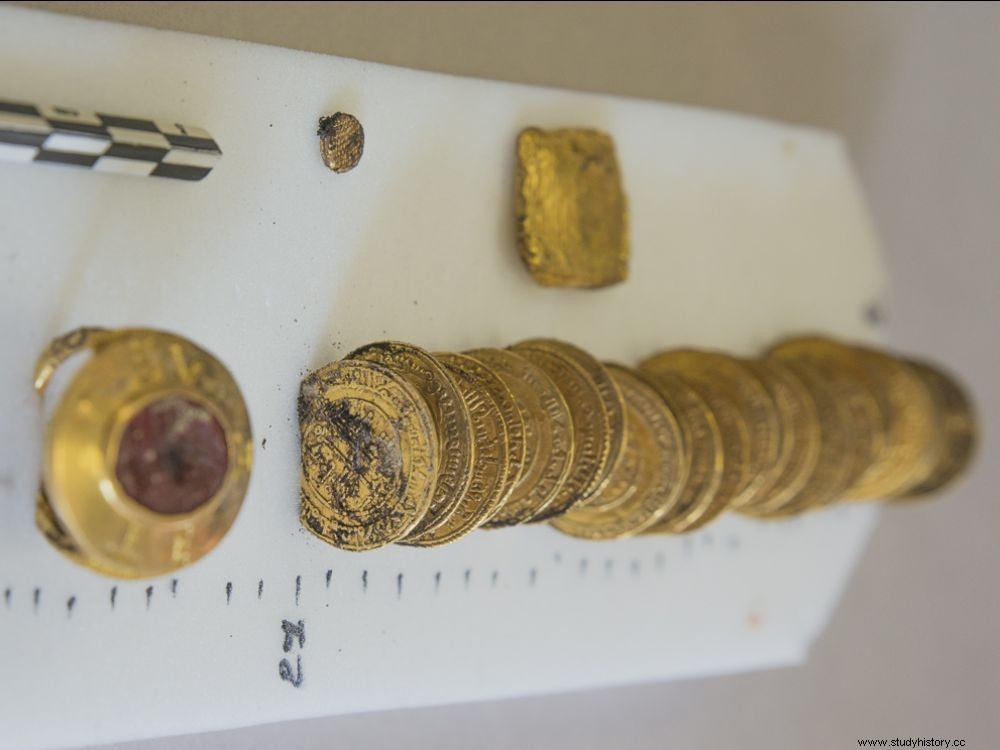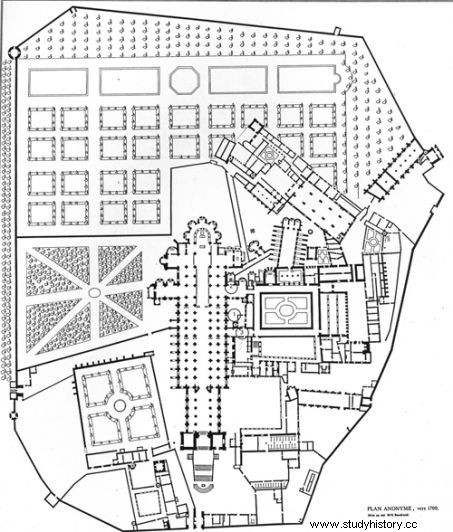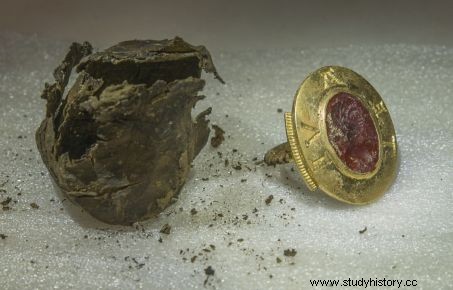A 12th-century medieval hoard containing (among other things) more than 2,200 silver denarii and 21 gold Muslim dinars was discovered at Cluny Abbey. And it was an archeology student who first saw the treasure during the excavations!

The 21 Muslim gold dinars, found among 2,200 silver denarii and obols in a treasure buried in Cluny.
TREASURE. "It is an exceptional discovery by its unique nature, but above all by the questions it raises about the abbey and its secrets" , enthuses Nathalie Dompnier, president of the Lumière Lyon 2 University. et-Loire):more than 2,200 deniers and obols in silver, 21 Muslim dinars in gold, a signet ring (for example used to seal and seal correspondence) and various gold items. "It is the first time that we find such elements in Cluny" , rejoices Anne Baud, teacher-researcher at Lyon 2 University in the Archeology and Archaeometry Laboratory.
A treasure buried 70 cm above the ground under the former monastic infirmary... spotted by a student!
The jackpot had been waiting wisely, buried under the current abbey garden, for 800 years. the medieval monastic infirmary, of which nothing remains on the surface today.You should know that there is only one historical plan of the abbey:the so-called anonymous plan of 1700, which certainly describes the buildings ... but after the vast dismemberment of 1623 which saw the deconstruction of old buildings to rebuild new ones" , explains Anne Flammin, CNRS engineer in the same laboratory. "The treasure was hidden in a simple hole in the backfill, to fill in an old wall that has now disappeared."
STUDENTS. A beautiful story in which the students of the Masters in Archeology of the university participated, who intervene on the excavations in order to train. It is thus "a student, during the very first day of excavations in September 2017, who saw the green pieces fall into the hole dug for the survey, after being grazed by a mechanical shovel!" , reveals Anne Flammin.

The "anonymous plan" of 1700
The mysterious presence of foreign currencies in gold
The composition (currency in silver, gold, ring and other gold elements) of this treasure raises many questions. Starting with the presence of gold Muslim dinars, far from their usual trading area, whereas in continental Europe, silver coins were mainly used at the time. "It is very rare to find 12th century coins in situ, in their historical context , recalls Anne Flammin.Most of the treasures are found by individuals using metal detectors and are then lost to history, even though it is an essential source."
DATING. "These dinars were minted in Spain and Morocco, it is easy to date them since their date of manufacture has been engraved there , says Vincent Borrel, PhD student at the Archeology and Philology of the East and West Laboratory. Thus they date from 1121 to 1131 and were minted in Spain and Morocco during the reign of Ali Ben Youssef of the Berber Almoravid dynasty." As for silver deniers and obols, their dating is more complex, because several origins are involved:the bishopric of Meaux between 1120 and 1134, the king of France, "surely Louis VII" , but also Cluny Abbey itself, which had the right to coin money! "The Cluniac denarii even form the vast majority of the silver denarii found" , adds Anne Baud.

Origin of the coins found
The hypotheses raised by a "romantic discovery"
"Cluny Abbey had contacts with Spain, which was then in the Muslim sphere of influence, so it makes sense to find dinars there. However, only 10 samples of gold dinars in France, which shows that such exchanges were reserved for important personages and exchanges" , evokes Vincent Borrel. And what was this treasure worth at the time? Little more than a personal fortune: "At the scale of an individual, this represents 3 to 8 horses, a substantial sum, but only 6 days of supply at the scale of the abbey! "
MYSTERIES. The treasure thus seems to have belonged to an individual, "perhaps to a religious dignitary, which the signet ring suggests", says Anne Baud. "But you should know that lay people could enter the abbey to die there... and sometimes leave." The 12th century also proved to be, for Cluny, a time of financial difficulties."It was the time when the new abbey was built, when the monks called for new funding." Perhaps the discovery will help shed light on the economic life of the abbey, which remains little known. As for the identity of the owner of the treasure, the mystery remains whole."Why hide such a treasure, then forget it? , asks Anne Baud. We are facing a historical discovery, but also a romantic one".

The signet ring found / Credits:Alexis Grattier / Lyon II University
